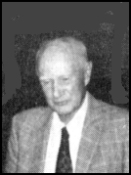
 |
EB Chirp, 1975 |
by "Shortfellow" Although I am told, that that patriot bold, rode right past here in the days of old. I'll tell you of someone almost as great, and that's our dear friend H. Roy Waite. Ninety years ago, this very day, Roy's father heard the doctor say: "It's a boy!" and thus in Roxbury town was born this man of great renown. Now father Waite was a man of the sea, and little Roy wanted also to be-- A sailor; so he studied 'bout oceans and ships, then over to Europe he made some trips. Home again, 1910, he happened to go to Squantum to see an a-ee-ro-plane show. And there he was Claude Graham-White, and Sopwith; and Ovington making a flight. Tom Milling was thrilling. Then at the Brockton Fair, Atwood and Lincoln Beachey were there. Then Roy burst forth with a shout of glee, "A flying man I want to be." At the General Aviation School in Boston, Mass., Roy joined an airplane-making class. He made ribs and spars and shoulder-yokes too, for a Curtiss Pusher with poles of bamboo. Atwood was the pilot, in a Burgess Wright. Five dollars a minute was charged for the flight. Roy wanted to fly it but Atwood said, "No! If you touch those levers, then out you go!" Roy paid for more rides. Flying was his dish, with Atwood, Arch Freeman, and Farnum Fish. But Roy, instead of just thinkin' and guessin', decided he'd teach our Armed Forces a lesson. So in 1912, on the 19th of May, Roy and Arch Freeman, before the dawn of day, Loaded an airplane with deadly power -- 12 bombs, made of bags filled with one pound of flour. They flew to Fort Heath and there they dropped one. It landed kerplop on a ten-inch gun. Another one hit on a range-finding station. Then on they flew to their next destination. Fort Banks was their target. Soon it lay below. Our Roy took aim and made a good throw. Three times he cast. He threw them just right. The Fort was clobbered with splotches of white. Nest to the Navy Yard. There they could see the warships "Rhode Island" and "New Jersey." Six bombs were heaved out and downward they sped. Within each bag was a note which read: "What if this bomb, instead of flour, contained nitroglycerin's deadly power?" Roy and Arch Freeman then homeward flew. Roy wondered what the Army and Navy would do. But those officers said with a disdainful grunt, "That's only a dern fooly Early Birds' stunt." Nine years later came Billy Mitchell's shocker when battleships went down to Davy Jones' locker. But back in 1911, 'though Roy tried real hard, he couldn't interest even the National Guard. In June of 1912 Roy purchased the plane in which Harry Atwood had gained great fame-- When he flew from Massachusetts with some stops along the way, to the White House in the Capital of the U.S.A. Roy raised forty-four humdred dollars to buy it, but he couldn't find anyone to teach him to fly it. So he sat in the seat and wiggled each lever to see what would happen. This boy was real clever. Then behind the wings he pulled down a prop. The engine sneezed and then went "plop-plop." Back at the controls Roy gave it the gas and started rolling along on the grass. With determination and guts and pluck, he bounced and jounced and then got unstuck. "Twas at Saugus he soloed and then learned more tricks, and received Aero License 186. He got some bad news when he learned he must pay the Wrights one hundred dollars a day Whenever he flew. Another condition was pay fifty dollars for the 'plane's exhibition. Roy founded the Cliftondale School of Aviation, and then flew for Burgess at Marblehead Station. Mel Hodgdon was there, for his flight lessons paying. He can verify all that I'm saying. WIth George Gray and Howard Rinehart, Roy flew in Carolina. They were fine fliers, but our Roy was finer. Back home, although folks said that no one could do it, Roy built a tailess airplane and flew it. Nineteen-fourteen, two chaps took Roy's Wright airplane. They crashed it completely. It never flew again. Roy was offered a job to fly in Mexico and chase Pancho Villa, but Roy said, "Oh no!" When Roy hung up his goggles and tallied his time, he'd had more than 250 hours of flying. That's a lot af air time for that long ago. There not many pilots made such a good show. And excepting one time when he splashed in a bog, he'd 2000 good landing in his flight log. He was Foreman for Sturtevant in 1915. State Inspector for Flying in 1916. Nineteen-seventeen---with Loening in Long Island Cit-ee, and was then called to duty in Washington, D.C. There he worked with the Navy as an aircraft inspector, next with the "Bu-Aer" as a technical Director. A high point of his career was that memorable day when Wright's Flyer returned to the U.S.A. After thirty-five years with the U.S. Navy, Roy retired and now is happy to be-- Back home in Norwood. We wish him "God Bless, and ninety more years of happiness." January 1975, Number 81 |


|